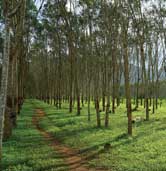It’s bad to have too much of a good thing. Surplus production capacity as a result of unusual expansion of mature tree area over the last five years (starting in 2016) has become a burden for the natural rubber economy. According to the ANRPC Rubber Market Intelligence Report for October 16-31, while the global mature area is predicted to expand by almost 250,000 hectares in 2022, the consequent increase in production is likely to be absorbed by a healthy global demand.
ANRPC cited an estimate from IMF’s World Economic Outlook released in October that following an 8.3% increase in 2021, global consumption is expected to expand at a rate of 4 to 5% in 2022, which is feasible and doable. When the latter happens, there will not be an NR surplus in 2022, ANRPC explained.
Furthermore, beginning in 2023, natural rubber is predicted to be in short supply globally, with the gap growing in successive years until 2028. According to forecasts based on planting trends and possible mature area expansion in specific countries, the protracted phase of shortfall could last until 2031. The report cautioned that the NR economy is on the verge of a long era of deficit, which will last until 2031 and will be marked by a worsening supply-demand mismatch.
To summarise, natural rubber prices are likely to continue to be supported in the short term by a favourable supply-demand scenario and improving crude oil prices. Pent-up demand due from the global economic recovery, a disproportionate increase in demand, and a projected 200,000-tonne shortage this year can all help NR prices rise further in the final two months of the year.
While the NR economy is expected to reach a balanced demand-supply position in 2022, it is expected to enter a long period of deficit by 2023 if demand grows at a low rate of 3.0%, ANRPC said, adding that the global NR economy is on the verge of emerging from a protracted period of excess production capacity and oversupply.

